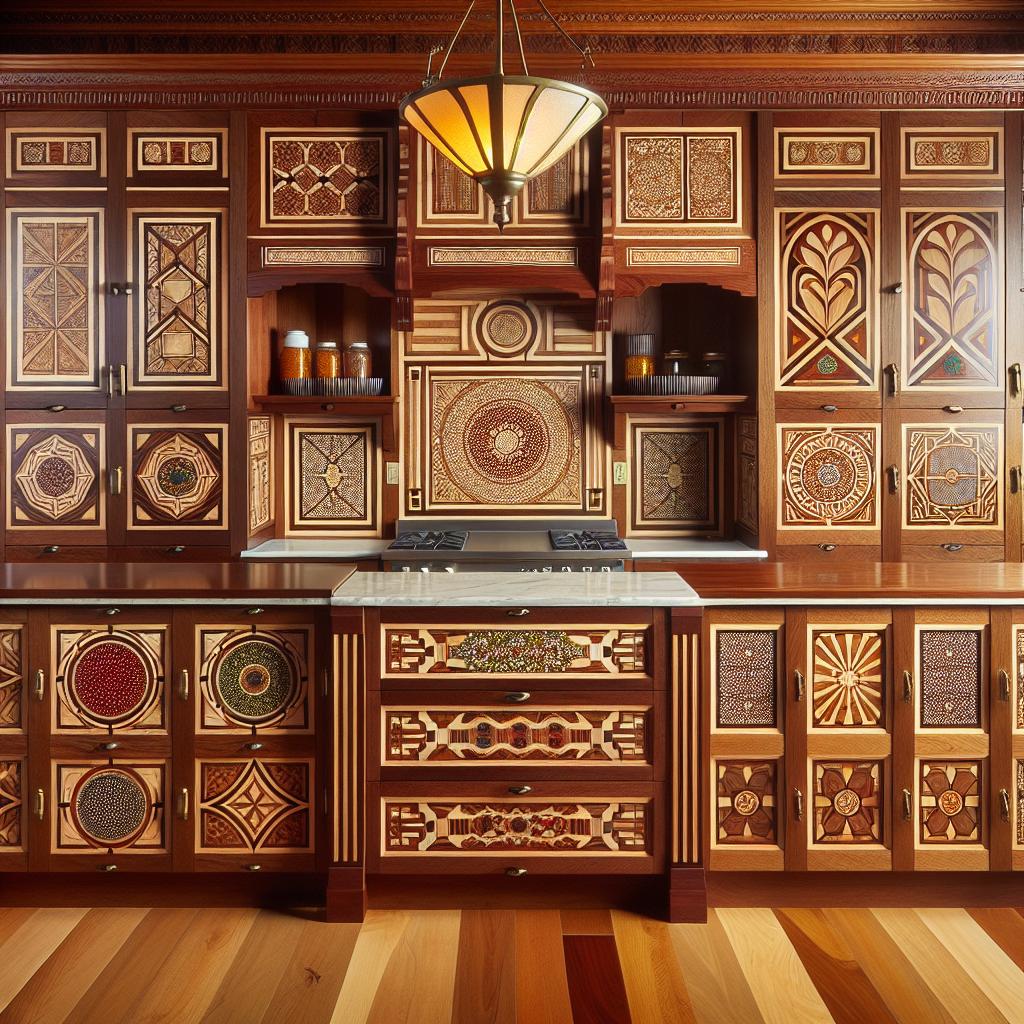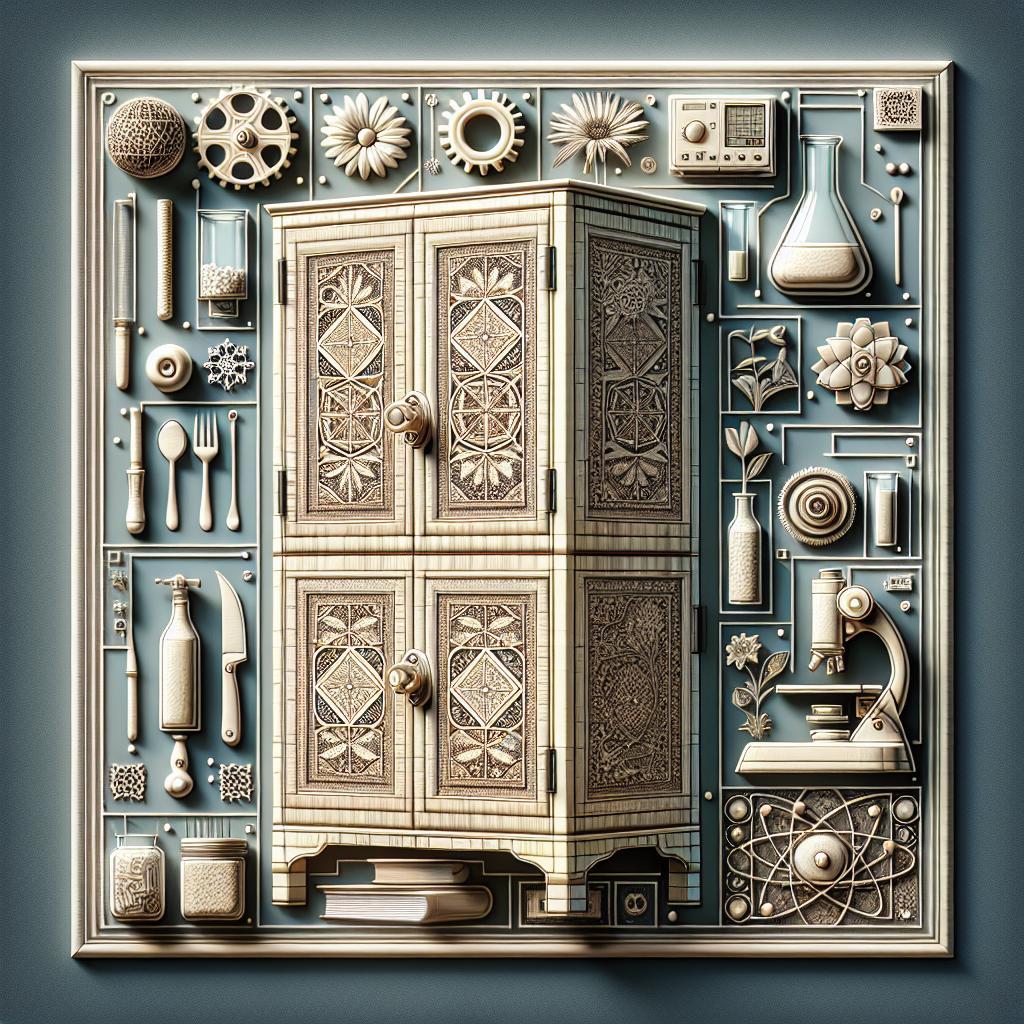In the realm of interior design, the details often speak louder than the overall aesthetic. Among the myriad ways to enhance a space, the art of cabinet design stands out, allowing for creativity to flourish while meeting practical needs. One of the most captivating techniques in this domain is the use of inlays—delicate patterns or materials embedded into cabinet surfaces that can transform ordinary storage into extraordinary focal points. This article delves into the world of designing cabinets with inlays, exploring the historical significance, various techniques, and endless possibilities that lie within this intricate craft. Whether you’re a seasoned designer seeking inspiration or a homeowner eager to add a personalized touch to your living spaces, join us as we unravel the beauty and sophistication that inlays can bring to cabinet design.
Exploring the Art of Inlay Design in Cabinetry
Inlay design is an exquisite technique that enriches the visual appeal and craftsmanship of cabinetry. This art form involves embedding contrasting materials such as wood, metal, or resin into a surface to create intricate patterns and motifs. The versatility of inlay allows designers and artisans to craft unique representations, reflecting personal styles or thematic elements. From geometric patterns to floral designs, the possibilities are almost endless. The meticulous process of executing inlays not only demands precision but also results in stunning visual depth, making every cabinet a centerpiece.
When embarking on a cabinetry project with inlays, consider the following elements for effective design:
- Material Selection: Choose materials that complement the overall cabinetry. Wood inlays can provide warmth, while metal inlays add a modern touch.
- Design Complexity: Striking a balance between simplicity and detail can enhance the cabinet’s appeal. Intricate inlays can be eye-catching but may overwhelm smaller pieces.
- Color Harmony: Ensure that the colors of the inlay and surrounding material are harmonious, creating a unified look.
| Inlay Material | Characteristics | Best Used For |
|---|---|---|
| Wood | Warm, natural feel | Traditional designs |
| Metal | Sleek, modern aesthetic | Contemporary styles |
| Resin | Colorful, versatile | Artistic or whimsical designs |
Materials Matter: Choosing the Right Inlay Materials for Your Cabinets
When selecting inlay materials for your cabinets, understanding the characteristics of each option is essential for achieving both aesthetic appeal and functional longevity. Here are some materials to consider:
- Wood Veneers: Offering a natural look, wood veneers come in various species, allowing for customization similar to solid wood but at a reduced weight and cost.
- Metal Accents: Stainless steel or brass inlays can add a touch of modernity and sophistication, enhancing durability and ease of maintenance.
- Glass Insets: Transparent or frosted glass can create depth and visual interest, providing contrast against wooden or lacquered surfaces while allowing light to filter through.
- Resin Fillers: Perfect for achieving vibrant colors and patterns, resin inlays can incorporate elements like crushed stone or glitter, offering a unique and artistic flair.
It’s also important to consider the harmony between your chosen materials and the overall design scheme. Each material interacts differently with light, texture, and style, so it’s crucial to envision how they mesh together:
| Material | Visual Effect | Durability |
|---|---|---|
| Wood Veneers | Warm & inviting | Moderate |
| Metal Accents | Sleek & modern | High |
| Glass Insets | Light & airy | Moderate |
| Resin Fillers | Vibrant & artistic | High |

Techniques and Tools: Mastering the Craft of Cabinet Inlay
Mastering the art of cabinet inlay requires both creativity and precision, making it essential to choose the right techniques and tools. Start with appropriate wood types as well as an understanding of grain patterns and colors to create stunning contrasts. Tools such as a router for shaping inlays and a chisel for fine detail work can elevate your designs. Consider using a dowel jig for aligning the inlays in place and a scroll saw or band saw for intricate cuts. Utilizing these tools effectively not only enhances the final product but also helps maintain the integrity of the wood throughout the process.
When designing your cabinet, take advantage of various inlay techniques that can add both depth and interest. Traditional methods like banding and marquetry allow for intricate designs, while bent lamination can create curved and flowing forms. It’s also worthwhile to explore modern methods such as laser cutting, which can offer precision in intricate designs. Here’s a simple comparison of some popular techniques:
| Technique | Pros | Cons |
|---|---|---|
| Banding | Easy to apply and versatile | May require patience for alignment |
| Marquetry | Allows for detailed designs | Time-consuming and intricate |
| Bent Lamination | Creates unique shapes | Requires specialized tools |
| Laser Cutting | High precision and repeatability | Can be expensive with setup |

Inspiration and Trends: Elevating Your Cabinets with Unique Inlay Patterns
When considering elevating your cabinetry, the introduction of unique inlay patterns opens a world of design possibilities. These intricate details transform ordinary cabinets into extraordinary focal points, allowing for personal expression and refined aesthetics. You might explore using materials such as mother-of-pearl, wood veneer, or even metal accents to create stunning inlays that reflect your unique style. Here are a few popular trends to inspire your design choices:
- Geometric Shapes: Incorporating bold geometric patterns adds a modern twist.
- Nature-Inspired Designs: Opt for organic shapes and motifs, like leaf patterns or floral inlays.
- Contrasting Colors: Use contrasting hues to create vibrant, eye-catching patterns.
The combination of these elements can revitalize traditional cabinetry and accommodate various home styles, from rustic charm to contemporary sleekness. Additionally, consider integrating inlays that tell a story or resonate with your personal interests. For instance, custom designs that incorporate personal symbols or align with cultural heritage can add a deeply personal touch to your cabinets. Here is a sample table highlighting popular inlay materials:
| Material | Characteristics | Best Used For |
|---|---|---|
| Mother-of-Pearl | Shimmering, iridescent finish | Elegant and luxurious designs |
| Wood Veneer | Warm, natural aesthetic | Rustic or traditional cabinetry |
| Metal Accents | Bold and contemporary look | Modern and industrial styles |
Q&A
Q&A: Designing Cabinets with Inlays
Q: What exactly is an inlay, and how does it enhance cabinet design?
A: An inlay is a decorative technique where a material is inserted into the surface of the cabinet, creating a striking visual effect. This might include wood, metal, or even stone, offering depth and detail that elevates the overall aesthetic. Inlays not only enhance the beauty of a cabinet but also allow for personalization and unique design elements that reflect the homeowner’s style.
Q: What materials can be used for inlays in cabinet design?
A: The possibilities are vast! Common materials include contrasting woods, metals like brass or copper, and even synthetic composites or acrylics. You can play with color, texture, and shine, enabling endless creativity. The choice largely depends on the style of the cabinet and the overall interior theme of the space.
Q: Are there specific styles of cabinets that work best with inlays?
A: Inlays can complement various cabinet styles. Traditional cabinets often feature intricate wood inlays that echo classic craftsmanship, while modern designs might incorporate sleek metal or geometric patterns. Ultimately, inlays can be tailored to fit practically any style—from rustic farmhouse to minimalist contemporary—making them a versatile choice.
Q: How do you ensure that inlays are durable and maintain their aesthetic appeal?
A: Durability starts with careful material selection. High-quality materials and proper installation techniques are crucial. Additionally, maintaining inlays often includes regular cleaning and occasionally polishing or refinishing the surfaces to keep them looking their best. Utilizing seals and finishes designed for the specific material can also enhance longevity.
Q: What are some design tips for incorporating inlays into cabinet design?
A: Start with a clear vision! Consider the overall space and how the inlays will complement existing décor. Subtle inlays may enhance classic styles, while bold designs can serve as statement pieces. Balance is key—ensure that inlays do not overwhelm the cabinet’s functionality. Lastly, experiment with scale; intricate details may look stunning on smaller cabinets, while larger pieces might benefit from simpler inlay patterns.
Q: Can inlays be used in DIY cabinet projects?
A: Absolutely! Adding inlays can be a rewarding DIY endeavor. However, it requires precision and patience. Start with simpler designs and practice on scrap materials before committing to your actual cabinets. There are many online resources and tutorials that can help you master the techniques needed for successful inlay work.
Q: How can inlays reflect personal style in cabinet design?
A: Inlays offer a unique opportunity to incorporate personal flair into your home. Whether you choose a vibrant geometric pattern or a delicate floral motif, inlays can express individuality in a subtle yet impactful way. This customization ensures that the cabinets not only serve a functional purpose but also convey the homeowner’s personal taste and artistic vision.
Q: What role does inlay play in enhancing the value of cabinetry?
A: Well-executed inlays can increase the aesthetic value of cabinetry significantly, which may appeal to potential buyers. Unique design features often set a home apart in the market. When crafted with care, inlaid cabinets can become a focal point of the space, showcasing quality craftsmanship that can resonate with discerning homeowners.
Q: Are there trends in inlay design that we should keep an eye on?
A: Trends in inlay design evolve, but some current favorites include mixed materials, where wood meets metal, and geometric patterns that embrace a modern aesthetic. Nature-inspired designs, such as organic shapes and botanical motifs, are also gaining popularity. As sustainable materials become more valuable, eco-friendly inlays could pave the way for future trends in cabinetry design.
Inlays provide an avenue for creativity and individuality in cabinet design, bridging functionality with artistry. Embrace the challenge, and let your cabinets tell a unique story!
To Wrap It Up
the art of designing cabinets with inlays is not merely a decorative choice; it’s a celebration of craftsmanship and creativity that elevates any space. As we’ve explored, inlays offer a versatile avenue for personal expression, allowing homeowners and designers alike to create unique pieces that reflect individual styles and tastes. From the intricate patterns to the choice of materials, each decision contributes to the overall story told by the cabinet, transforming a functional item into a statement piece.
As you embark on your own journey to incorporate inlays into your cabinet design, remember that the possibilities are as limitless as your imagination. Whether you choose bold geometric shapes, organic forms, or even custom motifs that have personal significance, the result will undoubtedly be a striking element in your home. So, gather your inspiration, unleash your creativity, and let the world of inlaid cabinetry inspire a new chapter in your design narrative.

